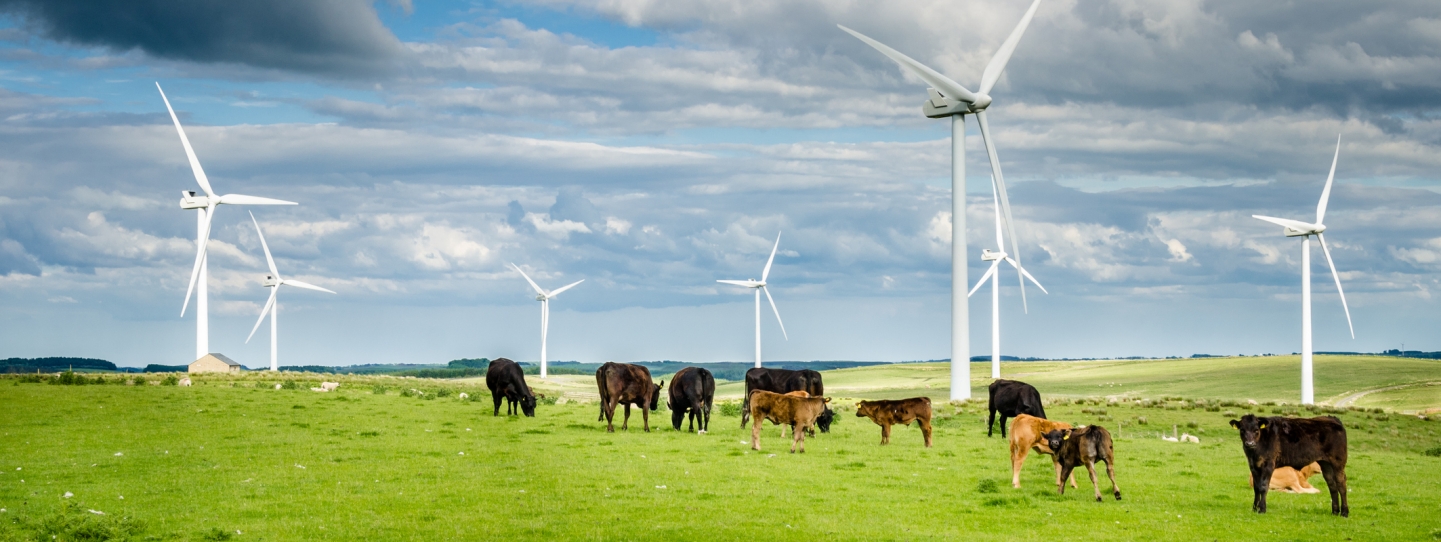
Photo: Cows in a pasture with a wind farm in background - stock photo
Best Practices for Integrating Renewable Energy Sources in Agriculture
In the EU-27 in 2021, the main sources of GHG emissions from agriculture were ruminant enteric fermentation (40%), fertilizer use (26%), fossil fuel combustion (17%), livestock effluent management (17%), liming (1%) and urea spreading (1%)* . Although energy consumption is not the first source of GHG emissions of the sector, the integration of renewable energy sources (RES) in agriculture offers good potential for reducing these emissions and supporting sustainable farming practices.
RES integration in agriculture can affect multiple different systems, from the farms themselves to local communities and biodiversity, and can involve transformative changes both in farm management and production processes. These changes can have significant benefits, but also come with key challenges for all the different systems affected. Addressing these key challenges and harnessing the full potential and benefits of RES integration in agriculture requires tailored approaches in the context of each farm type or renewable energy source. The HarvRESt project has already identified promising best practices that can be applied either to specific RES or across systems.
Wind energy
Wind energy can offer farmers stable energy and decrease their overall costs by enhancing energy security. Hybrid systems combining wind and solar can further enhance reliability. Among the best practices identified are the proper site selection and turbine type.
Placing turbines in high-wind areas ensures efficiency while reducing environmental impacts such as bird habitat disruption. Moreover, the selection of crops suited to altered wind conditions near turbines is critical. Turbines can also be integrated in grazing areas to avoid interference with crop yields. Lastly, the involvement of external investors can help overcome high initial costs, making wind projects more feasible for farmers.
Solar energy
Solar energy has great potential to be exploited in agriculture. For instance, agrivoltaics can support biodiversity, reduce water evaporation, and increase crop yields. Additionally, integrating solar-powered monitoring technologies enhances precision farming and energy efficiency. Tailoring PV Systems to crop type, infrastructure and location of the farm is an important practice to enhance the integration of solar energy in agriculture. Moreover, regular monitoring post-installation ensures solar systems are functioning optimally, helping mitigate technical and financial risks. More importantly, engaging local communities and forming cooperatives can foster support for solar installations.
Biomass
Using biomass to generate heat and power can be a solution to diversify income streams for farmers and to improve resource efficiency on farms, as part of a circular economy strategy. A significant best practice related to biomass energy is the use of agricultural residues. Prioritizing using farm waste and residues for biomass energy production can reduce risks of competition with food production and enhancing sustainability. Conducting thorough planning to select appropriate biomass technologies and sources, ensuring alignment with farm operations and sustainability goals, is key.
Hydropower
Hydropower offers reliable, localized energy for farms with suitable water resources, particularly in regions where irrigation infrastructure already exists. Incorporating hydropower into existing irrigation systems allows farms to harness renewable energy while optimizing water usage. Another important technological solution is Pump as Turbine (PAT) technology that deploy micro-hydropower solutions efficiently, without the need for large dams or reservoirs.
Geothermal energy
Geothermal energy can sustainably heat greenhouses, reducing energy costs and enabling year-round production, particularly for horticulture. Moreover, the combination of geothermal energy with other systems, such as heating pumps and irrigation, can maximize energy utilization.
Education and training
Beyond specific RES, some best practices should be applied across all systems. First, education and training are crucial for every RES type and farm type. To ensure that renewable systems are run effectively, farm operators and employees must have good knowledge of technologies and their maintenance needs. Depending on farm conditions, different renewable energy sources can be combined.
Storage
Improving storage capacities and employing energy management systems that can monitor, and control energy consumption and generation are crucial to enhance energy efficiency and allow better integration of all different RES. Favoring RES systems with limited soil footprint, with minimal impact on agricultural production or biodiversity conservation, is important.
Finally, in order to contribute efficiently to the reduction of a farm’s climate impact, renewable energy systems integration must be part of an overarching farm strategy to reduce GHG emissions and improve soil carbon sequestration. This can include manure management, intermediate crops, or agroforestry.
Many benefits
By adopting these best practices, farmers can overcome key challenges and unlock the benefits of renewable energy integration in agriculture. Through careful planning, community involvement, and technological innovation, renewable energy can enhance sustainability, reduce costs for the farmers, and increase farm resilience to climate change.
Further information
In the newly published HarvRESt report "Mapping of RES integration in farms at EU level" you can read more about best practices for integrating renewable energy sources in agriculture.
